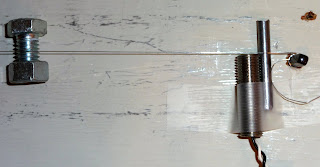This is a work in progress.
I made some new string samples, this time using a more solid base and bridge setup, so that the notes sounded better. Here’s a picture of the end of the bench. 
On the far right is the zither tuning pin (from Bart Hopkin’s Experimental Musical Instruments online store.) Then a small metal rod as the bridge on one end, and next the magnetic transducer. Notice how close to the bridge it’s located. This gives the strings more of a harpsichord sound than guitar. The left end of the picture is the movable bridge. In this picture it’s a very short string, making a very high note. The longest ones are around 15′. Notice also the rugged method which which the transducer is mounted: scotch tape. It only has to last a few minutes while I record the samples.
Then it’s on to CoolEdit to crop and tune the samples:
On the CoolEdit screen you can see the waveform of the string in green on the right. This is the first part of a sample at D#7 22 cents flat. That’s a very high note. I try to edit out any silence from the start of the note so that the attack happens when I expect it. Csound adjusts the pitch by moving it up 22 cents during sound generation.
Here’s how it sounds in a the Serenade I’ve been working on:
or download this link

